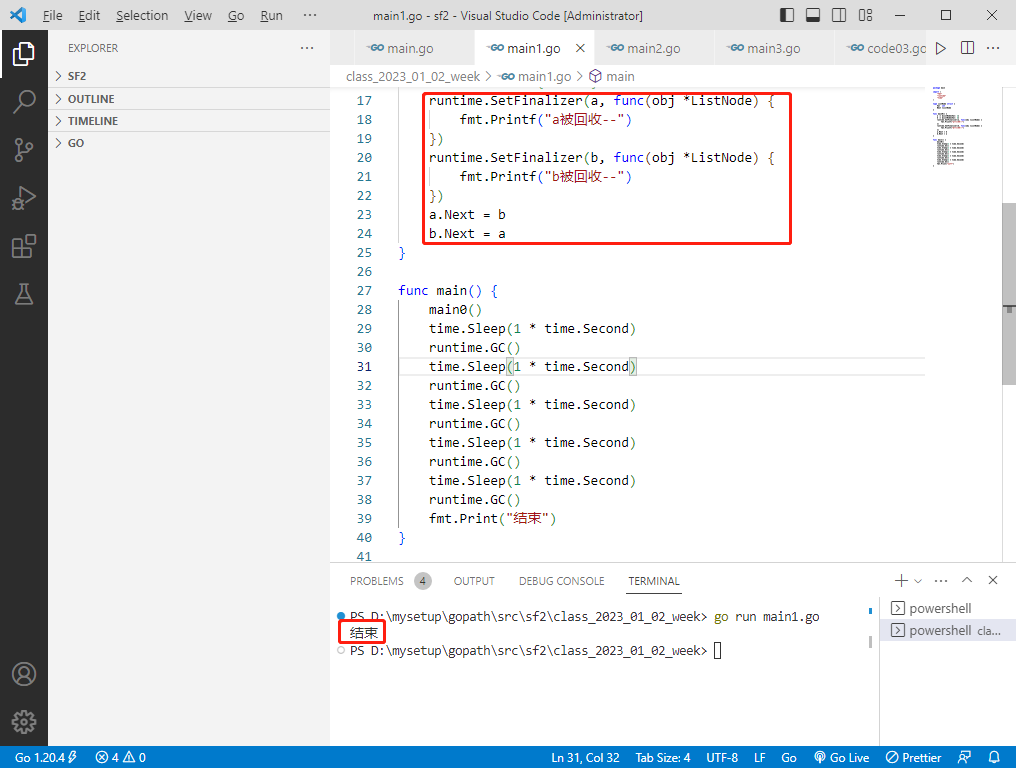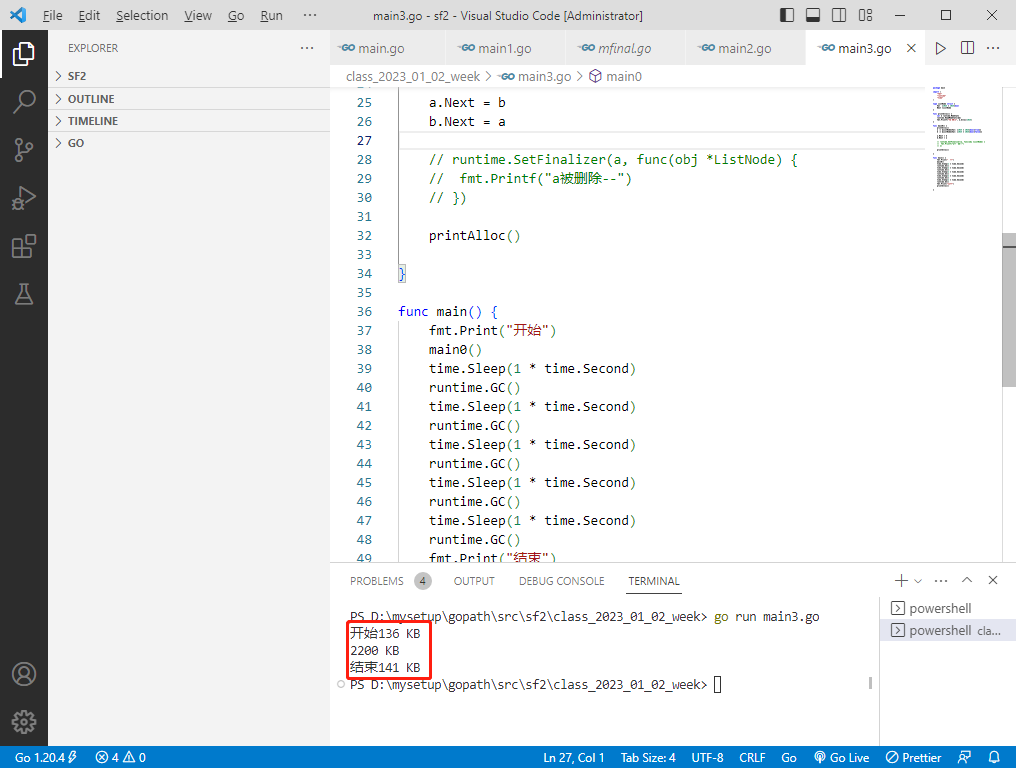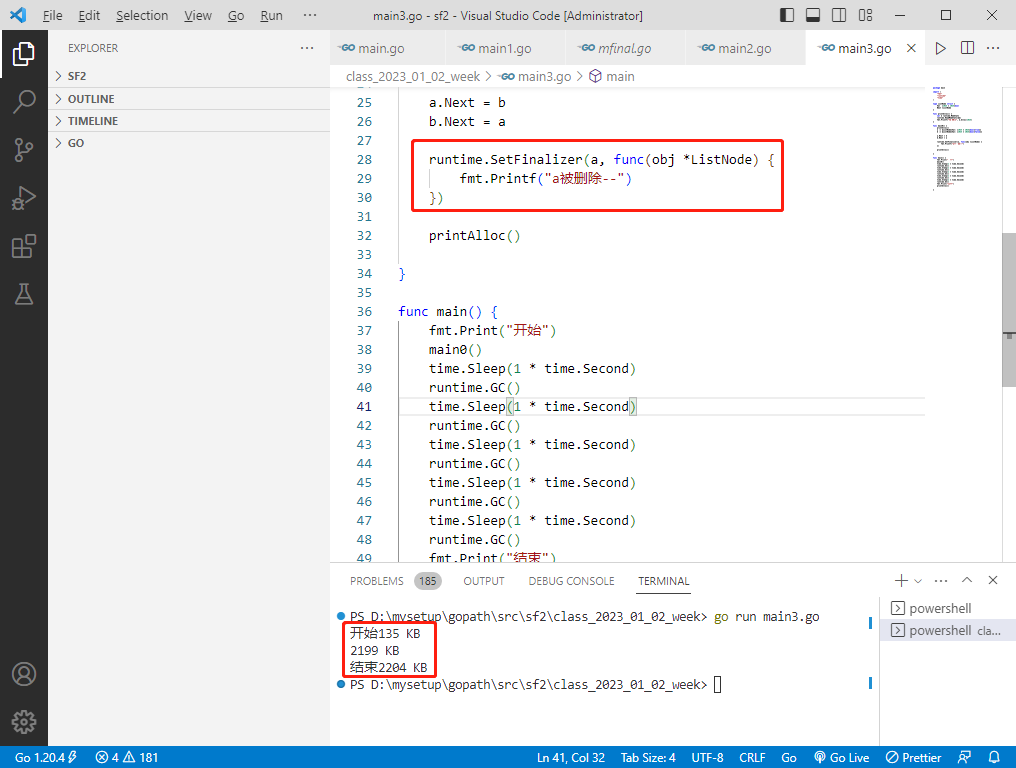

2023-05-26:golang关于垃圾回收和析构函数的选择题,多数人会选错。 - 福大大架构师...
source link: https://www.cnblogs.com/moonfdd/p/17435799.html
Go to the source link to view the article. You can view the picture content, updated content and better typesetting reading experience. If the link is broken, please click the button below to view the snapshot at that time.

2023-05-26:golang关于垃圾回收和析构函数的选择题,多数人会选错。
2023-05-26:golang关于垃圾回收和析构的选择题,代码如下:
package main
import (
"fmt"
"runtime"
"time"
)
type ListNode struct {
Val int
Next *ListNode
}
func main0() {
a := &ListNode{Val: 1}
b := &ListNode{Val: 2}
runtime.SetFinalizer(a, func(obj *ListNode) {
fmt.Printf("a被回收--")
})
runtime.SetFinalizer(b, func(obj *ListNode) {
fmt.Printf("b被回收--")
})
a.Next = b
b.Next = a
}
func main() {
main0()
time.Sleep(1 * time.Second)
runtime.GC()
time.Sleep(1 * time.Second)
runtime.GC()
time.Sleep(1 * time.Second)
runtime.GC()
time.Sleep(1 * time.Second)
runtime.GC()
time.Sleep(1 * time.Second)
runtime.GC()
fmt.Print("结束")
}
代码的运行结果是什么?并说明原因。注意析构是无序的。
B. a被回收--b被回收--结束
C. b被回收--a被回收--结束
D. B和C都有可能
答案2023-05-26:
golang的垃圾回收算法跟java一样,都是根可达算法。代码中main0函数里a和b是互相引用,但是a和b没有外部引用。因此a和b会被当成垃圾被回收掉。而析构函数的调用不是有序的,所以B和C都有可能,答案选D。让我们看看答案是什么,如下:

看运行结果,答案不是选D,而是选A。这肯定会出乎很多人意料,golang的垃圾回收算法是根可达算法难不成是假的,大家公认的八股文难道是错的?有这个疑问是好事,但不能全盘否定。让我们看看析构函数的源码吧。代码在 src/runtime/mfinal.go 中,如下:
// SetFinalizer sets the finalizer associated with obj to the provided
// finalizer function. When the garbage collector finds an unreachable block
// with an associated finalizer, it clears the association and runs
// finalizer(obj) in a separate goroutine. This makes obj reachable again,
// but now without an associated finalizer. Assuming that SetFinalizer
// is not called again, the next time the garbage collector sees
// that obj is unreachable, it will free obj.
//
// SetFinalizer(obj, nil) clears any finalizer associated with obj.
//
// The argument obj must be a pointer to an object allocated by calling
// new, by taking the address of a composite literal, or by taking the
// address of a local variable.
// The argument finalizer must be a function that takes a single argument
// to which obj's type can be assigned, and can have arbitrary ignored return
// values. If either of these is not true, SetFinalizer may abort the
// program.
//
// Finalizers are run in dependency order: if A points at B, both have
// finalizers, and they are otherwise unreachable, only the finalizer
// for A runs; once A is freed, the finalizer for B can run.
// If a cyclic structure includes a block with a finalizer, that
// cycle is not guaranteed to be garbage collected and the finalizer
// is not guaranteed to run, because there is no ordering that
// respects the dependencies.
//
// The finalizer is scheduled to run at some arbitrary time after the
// program can no longer reach the object to which obj points.
// There is no guarantee that finalizers will run before a program exits,
// so typically they are useful only for releasing non-memory resources
// associated with an object during a long-running program.
// For example, an os.File object could use a finalizer to close the
// associated operating system file descriptor when a program discards
// an os.File without calling Close, but it would be a mistake
// to depend on a finalizer to flush an in-memory I/O buffer such as a
// bufio.Writer, because the buffer would not be flushed at program exit.
//
// It is not guaranteed that a finalizer will run if the size of *obj is
// zero bytes, because it may share same address with other zero-size
// objects in memory. See https://go.dev/ref/spec#Size_and_alignment_guarantees.
//
// It is not guaranteed that a finalizer will run for objects allocated
// in initializers for package-level variables. Such objects may be
// linker-allocated, not heap-allocated.
//
// Note that because finalizers may execute arbitrarily far into the future
// after an object is no longer referenced, the runtime is allowed to perform
// a space-saving optimization that batches objects together in a single
// allocation slot. The finalizer for an unreferenced object in such an
// allocation may never run if it always exists in the same batch as a
// referenced object. Typically, this batching only happens for tiny
// (on the order of 16 bytes or less) and pointer-free objects.
//
// A finalizer may run as soon as an object becomes unreachable.
// In order to use finalizers correctly, the program must ensure that
// the object is reachable until it is no longer required.
// Objects stored in global variables, or that can be found by tracing
// pointers from a global variable, are reachable. For other objects,
// pass the object to a call of the KeepAlive function to mark the
// last point in the function where the object must be reachable.
//
// For example, if p points to a struct, such as os.File, that contains
// a file descriptor d, and p has a finalizer that closes that file
// descriptor, and if the last use of p in a function is a call to
// syscall.Write(p.d, buf, size), then p may be unreachable as soon as
// the program enters syscall.Write. The finalizer may run at that moment,
// closing p.d, causing syscall.Write to fail because it is writing to
// a closed file descriptor (or, worse, to an entirely different
// file descriptor opened by a different goroutine). To avoid this problem,
// call KeepAlive(p) after the call to syscall.Write.
//
// A single goroutine runs all finalizers for a program, sequentially.
// If a finalizer must run for a long time, it should do so by starting
// a new goroutine.
//
// In the terminology of the Go memory model, a call
// SetFinalizer(x, f) “synchronizes before” the finalization call f(x).
// However, there is no guarantee that KeepAlive(x) or any other use of x
// “synchronizes before” f(x), so in general a finalizer should use a mutex
// or other synchronization mechanism if it needs to access mutable state in x.
// For example, consider a finalizer that inspects a mutable field in x
// that is modified from time to time in the main program before x
// becomes unreachable and the finalizer is invoked.
// The modifications in the main program and the inspection in the finalizer
// need to use appropriate synchronization, such as mutexes or atomic updates,
// to avoid read-write races.
func SetFinalizer(obj any, finalizer any) {
if debug.sbrk != 0 {
// debug.sbrk never frees memory, so no finalizers run
// (and we don't have the data structures to record them).
return
}
e := efaceOf(&obj)
etyp := e._type
if etyp == nil {
throw("runtime.SetFinalizer: first argument is nil")
}
if etyp.kind&kindMask != kindPtr {
throw("runtime.SetFinalizer: first argument is " + etyp.string() + ", not pointer")
}
ot := (*ptrtype)(unsafe.Pointer(etyp))
if ot.elem == nil {
throw("nil elem type!")
}
if inUserArenaChunk(uintptr(e.data)) {
// Arena-allocated objects are not eligible for finalizers.
throw("runtime.SetFinalizer: first argument was allocated into an arena")
}
// find the containing object
base, _, _ := findObject(uintptr(e.data), 0, 0)
if base == 0 {
// 0-length objects are okay.
if e.data == unsafe.Pointer(&zerobase) {
return
}
// Global initializers might be linker-allocated.
// var Foo = &Object{}
// func main() {
// runtime.SetFinalizer(Foo, nil)
// }
// The relevant segments are: noptrdata, data, bss, noptrbss.
// We cannot assume they are in any order or even contiguous,
// due to external linking.
for datap := &firstmoduledata; datap != nil; datap = datap.next {
if datap.noptrdata <= uintptr(e.data) && uintptr(e.data) < datap.enoptrdata ||
datap.data <= uintptr(e.data) && uintptr(e.data) < datap.edata ||
datap.bss <= uintptr(e.data) && uintptr(e.data) < datap.ebss ||
datap.noptrbss <= uintptr(e.data) && uintptr(e.data) < datap.enoptrbss {
return
}
}
throw("runtime.SetFinalizer: pointer not in allocated block")
}
if uintptr(e.data) != base {
// As an implementation detail we allow to set finalizers for an inner byte
// of an object if it could come from tiny alloc (see mallocgc for details).
if ot.elem == nil || ot.elem.ptrdata != 0 || ot.elem.size >= maxTinySize {
throw("runtime.SetFinalizer: pointer not at beginning of allocated block")
}
}
f := efaceOf(&finalizer)
ftyp := f._type
if ftyp == nil {
// switch to system stack and remove finalizer
systemstack(func() {
removefinalizer(e.data)
})
return
}
if ftyp.kind&kindMask != kindFunc {
throw("runtime.SetFinalizer: second argument is " + ftyp.string() + ", not a function")
}
ft := (*functype)(unsafe.Pointer(ftyp))
if ft.dotdotdot() {
throw("runtime.SetFinalizer: cannot pass " + etyp.string() + " to finalizer " + ftyp.string() + " because dotdotdot")
}
if ft.inCount != 1 {
throw("runtime.SetFinalizer: cannot pass " + etyp.string() + " to finalizer " + ftyp.string())
}
fint := ft.in()[0]
switch {
case fint == etyp:
// ok - same type
goto okarg
case fint.kind&kindMask == kindPtr:
if (fint.uncommon() == nil || etyp.uncommon() == nil) && (*ptrtype)(unsafe.Pointer(fint)).elem == ot.elem {
// ok - not same type, but both pointers,
// one or the other is unnamed, and same element type, so assignable.
goto okarg
}
case fint.kind&kindMask == kindInterface:
ityp := (*interfacetype)(unsafe.Pointer(fint))
if len(ityp.mhdr) == 0 {
// ok - satisfies empty interface
goto okarg
}
if iface := assertE2I2(ityp, *efaceOf(&obj)); iface.tab != nil {
goto okarg
}
}
throw("runtime.SetFinalizer: cannot pass " + etyp.string() + " to finalizer " + ftyp.string())
okarg:
// compute size needed for return parameters
nret := uintptr(0)
for _, t := range ft.out() {
nret = alignUp(nret, uintptr(t.align)) + uintptr(t.size)
}
nret = alignUp(nret, goarch.PtrSize)
// make sure we have a finalizer goroutine
createfing()
systemstack(func() {
if !addfinalizer(e.data, (*funcval)(f.data), nret, fint, ot) {
throw("runtime.SetFinalizer: finalizer already set")
}
})
}
看代码,看不出什么。其端倪在注释中。注意如下注释:
// Finalizers are run in dependency order: if A points at B, both have
// finalizers, and they are otherwise unreachable, only the finalizer
// for A runs; once A is freed, the finalizer for B can run.
// If a cyclic structure includes a block with a finalizer, that
// cycle is not guaranteed to be garbage collected and the finalizer
// is not guaranteed to run, because there is no ordering that
// respects the dependencies.
这段英文翻译成中文如下:
Finalizers(终结器)按照依赖顺序运行:如果 A 指向 B,两者都有终结器,并且它们除此之外不可达,则仅运行 A 的终结器;一旦 A 被释放,可以运行 B 的终结器。如果一个循环结构包含一个具有终结器的块,则该循环体不能保证被垃圾回收并且终结器不能保证运行,因为没有符合依赖关系的排序方式。
这意思很明显了,析构函数会检查当前对象A是否有外部对象指向当前对象A。如果有外部对象指向当前对象A时,A的析构是无法执行的;如果有外部对象指向当前对象A时,A的析构才能执行。
代码中的a和b是循环依赖,当析构判断a和b时,都会有外部对象指向a和b,析构函数无法执行。析构无法执行,内存也无法回收。因此答案选A。
去掉析构函数后,a和b肯定会被释放的。不用析构函数去证明,那如何证明呢?用以下代码就可以证明,代码如下:
package main
import (
"fmt"
"runtime"
"time"
)
type ListNode struct {
Val [1024 * 1024]bool
Next *ListNode
}
func printAlloc() {
var m runtime.MemStats
runtime.ReadMemStats(&m)
fmt.Printf("%d KB\n", m.Alloc/1024)
}
func main0() {
printAlloc()
a := &ListNode{Val: [1024 * 1024]bool{true}}
b := &ListNode{Val: [1024 * 1024]bool{false}}
a.Next = b
b.Next = a
// runtime.SetFinalizer(a, func(obj *ListNode) {
// fmt.Printf("a被删除--")
// })
printAlloc()
}
func main() {
fmt.Print("开始")
main0()
time.Sleep(1 * time.Second)
runtime.GC()
time.Sleep(1 * time.Second)
runtime.GC()
time.Sleep(1 * time.Second)
runtime.GC()
time.Sleep(1 * time.Second)
runtime.GC()
time.Sleep(1 * time.Second)
runtime.GC()
fmt.Print("结束")
printAlloc()
}

根据运行结果,内存大小明显变小,说明a和b已经被回收了。
让我们再看看有析构函数的情况,运行结果是咋样的,如下:
package main
import (
"fmt"
"runtime"
"time"
)
type ListNode struct {
Val [1024 * 1024]bool
Next *ListNode
}
func printAlloc() {
var m runtime.MemStats
runtime.ReadMemStats(&m)
fmt.Printf("%d KB\n", m.Alloc/1024)
}
func main0() {
printAlloc()
a := &ListNode{Val: [1024 * 1024]bool{true}}
b := &ListNode{Val: [1024 * 1024]bool{false}}
a.Next = b
b.Next = a
runtime.SetFinalizer(a, func(obj *ListNode) {
fmt.Printf("a被删除--")
})
printAlloc()
}
func main() {
fmt.Print("开始")
main0()
time.Sleep(1 * time.Second)
runtime.GC()
time.Sleep(1 * time.Second)
runtime.GC()
time.Sleep(1 * time.Second)
runtime.GC()
time.Sleep(1 * time.Second)
runtime.GC()
time.Sleep(1 * time.Second)
runtime.GC()
fmt.Print("结束")
printAlloc()
}

根据运行结果,有析构函数的情况下,a和b确实是无法被回收。
1.不要怀疑八股文的正确性,golang的垃圾回收确实是根可达算法。
2.不要用析构函数去测试无用对象被回收的情况,上面的例子也看到了,两对象的循环引用,析构函数的测试结果就是错误的。只能根据内存变化,看无用对象是否被回收。
3.在写代码的时候,能手动设置引用为nil,最好手动设置,这样能更好的避免内存泄漏。
Recommend
About Joyk
Aggregate valuable and interesting links.
Joyk means Joy of geeK